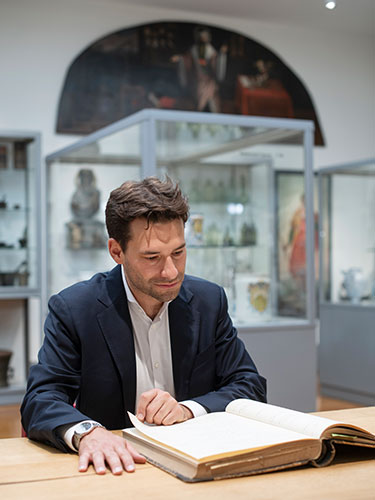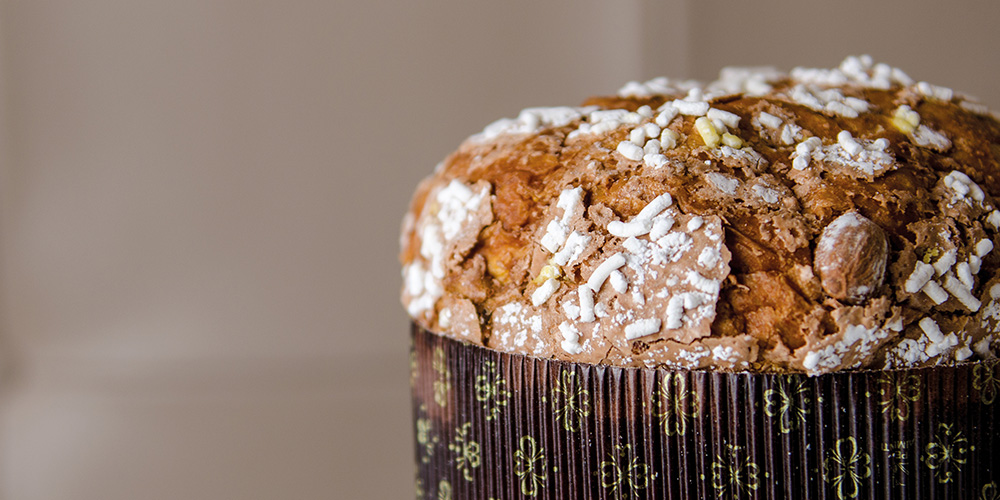100 years of the Pharmacy Museum: “Physicality, illness and healing affect us all”
The University of Basel’s Pharmacy Museum is celebrating its 100th anniversary with a festival, special exhibition and other events. Its director, historian Dr. Philippe Wanner, discusses the origins and history of the collection – and how it aims to be a modern museum without losing any of its historical character.
11 September 2025 | Christoph Dieffenbacher
Mr. Wanner, do you remember the first time you visited the Pharmacy Museum?
Yes, it was during my studies, on a Basel Museums Night, when I wanted to check out what was on offer with some friends. All I remember is that there were an impressive number of people in the Pharmacy Museum and that I was fascinated by the museum. I don’t remember any details.
By now, I’m sure you know the collection inside and out. What is your favorite object today?
Even after more than ten years at the museum, I am still far from knowing all the objects. At the moment it is the “Eingangsbuch” (the Book of Entries), a large-format volume in which thousands of objects recorded from the museum’s founding until 1992 are listed. For almost every individual object, there are notes about where and how it came to the museum. The volume is an exciting source on our own history, which we have now presented in a special exhibition. It is also informative to see how the objects were described at the time, what value they constituted for the collection and what role they play in the narrative of the exhibition.
The collection gives the impression that it is a patchwork of old pharmacy vessels, expired medicines and disused scales and weights. How did that result in a museum?
The Basel pharmacist and university lecturer Josef Anton Häfliger had put together a collection on the history of pharmacy in his own home. He held lectures on the history of pharmacy at the Pharmazeutische Anstalt [Pharmaceutical Institute], the predecessor of the Department of Pharmaceutical Sciences, which had already been located in the same building complex as the museum since 1917, although the latter was founded a little later. Häfliger often lacked material for practical demonstrations in his classes.
In 1925 he donated his collection to the university in order to preserve the objects for teaching. In addition, the industrialization of drug production had brought about a radical change in the pharmaceutical industry. The pharmacies were no longer the only ones producing tablets and ointments, but increasingly the big factories. The idea was the objects would preserve the craftsmanship and scientific knowledge of the manufacture of remedies in pharmacies.
Like many museums, the Pharmacy Museum was founded on the basis of a private collection. Have you also made active acquisitions?
Yes, and to this day, the museum is able to accept donations on an ongoing basis, from individual items to entire pharmacy equipment sets. In recent years, objects such as a heavy distillation oven, analytical equipment and a blister machine have been added. Three decades ago, the museum acquired a very extensive bundle of drug advertisements, which is currently being added to the collection. Such advertisements are an interesting reflection of society. From time to time, we can purchase things if the funds are available.
The museum is said to have a total of around 50,000 objects, including, surprisingly, prehistoric material. How much of this is on display at all times, and where is the rest stored?
According to our estimates, there are around 4,000 individual pieces on display in the permanent exhibition. This proportion is extremely high compared to other museums. We are a classic teaching collection and we want to show students the abundance of our objects. The objects that are not on public display are stored professionally in cellars and other rooms as well as in a larger outdoor depot in Basel’s Gotthelf quarter.
The museum has hardly changed for decades. Has anything been missed?
Since the 1930s, only a little has been exchanged or replaced. The permanent exhibition has retained its original character, which is unique far and wide. We see ourselves as a “museum within a museum”, as one that is in itself a museum exhibit. The museum’s founder wanted to show off a history of pharmacy’s progress – the path from an old craft to a scientific discipline. Today, we try to put this linear thinking into perspective and place it in a new context. We want to present the historical collection in a contemporary setting.
How do you do that?
In addition to the permanent exhibition, we regularly display special exhibitions and present the collection in public tours, audio guides, workshops and publications. We also conduct research – on historical medicines, for example – and examine the exhibits using interdisciplinary methods. Filling the collection with screens and loudspeakers would be wrong – it would destroy its charm.
What have been the highlights and times of crisis for the museum?
The fact that the museum came into being in the first place was certainly an initial success for Häfliger, the pharmacist community and the academic discipline of pharmacy. Immediately after its founding, a highly regarded international congress took place, which also gave impetus to pharmaceutical historical research and other museums. A crisis arose in the 1970s, when the Department of Pharmacy was temporarily threatened with closure. Around the year 2000, the decision was made to move away from a purely academic collection and open things up to a wider public. The original furniture of the old Barfüsser Pharmacy from 1900 was set up in its entirety in the museum’s entrance area and repurposed into a shop and cashier area.
Physicality, illness and healing affect us all throughout our lives.
The history of medicine and pharmacy seems to attract a larger audience. Why is that?
Yes, the museum is currently experiencing increasing numbers of visitors. Physicality, illness and healing affect us all throughout our lives. The vast majority of people have taken medicine at some point. The effects of medications and natural remedies are discussed, although here and there we come across ideas that seem less modern. Such as with Paracelsus in the 16th century, who said that certain plants have a healing effect because they have the shape and color of the sick part of the body, such as eyebright. By the way, his view was controversial even in his time.
The museum also exhibits amulets and healing crystals, and even an entire alchemist’s laboratory. Does this include the “philosopher’s stone” with wisdom on how a contemporary museum should present itself?
This stone, which stirred the alchemists, is not necessarily to be understood materially, but rather as a mode, a movement of knowledge. With this in mind, we want to tell the public exciting histories from the world of pharmacy as vividly as possible through our objects and research. If we manage to astonish people in the process, then we’ve found our philosopher’s stone.
Where Paracelsus left his mark
The University of Basel’s Pharmacy Museum is home to one of the world’s largest and most significant collections of objects from the history of pharmacy. It is the only one of its kind in Switzerland and essentially comprises a scientific collection dating from around 1930. The museum is housed in the “Zum Vorderen Sessel” building at Totengässlein 3. Among others, printers Johannes Amerbach and Johannes Frobenius lived and worked here, as did scholars such as Erasmus of Rotterdam and Theophrastus of Hohenheim, also known as Paracelsus.
The Museum of Pharmacy is celebrating its anniversary with a series of public events with the theme 100 years of collecting, researching, astonishing, running until February 2026. The anniversary program will officially kick off with a two-day festival on 20–21 September, featuring workshops, guided tours, a bar, dance music and much more. In a special exhibition and a book publication, the museum will be presenting its own history and also wants to show off its hidden sides.



